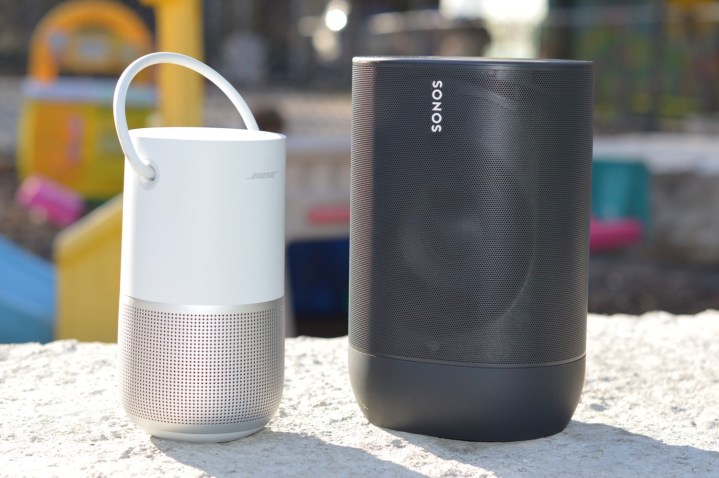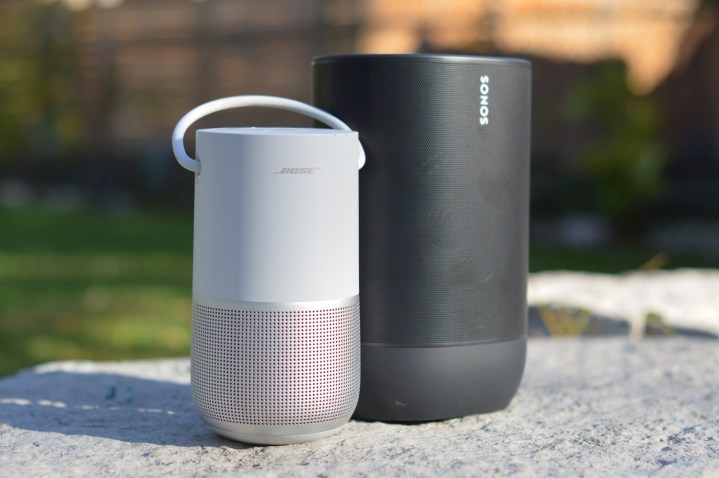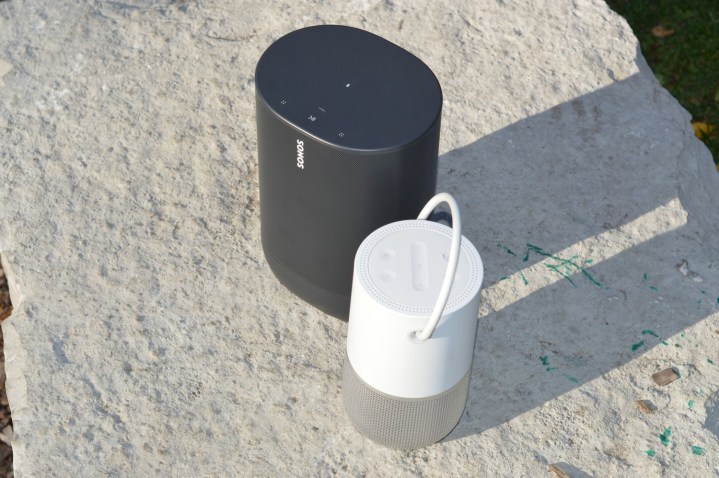
Launched within weeks of each other, the $399 Sonos Move and $350 Bose Portable Home Speaker are both hoping to find a spot on coffee tables and picnic benches wherever people gather and want to listen to music. Similar in functionality (both offer Bluetooth, Wi-Fi, AirPlay 2, and your choice of Alexa or Google Assistant), they will nonetheless appeal to slightly different buyers — and not just because of the price difference. To understand why, here’s our head-to-head comparison of these superb wireless and portable smart speakers.
Portability
Let’s start with the one thing that really separates these speakers from almost every other wireless smart speaker: Portability. So what makes a portable speaker, well, portable? Size, weight, a handle or other grabbable feature, and a battery to power it. Both the Move and the Portable Home Speaker have batteries, so it’s really down to the other three elements and the Bose nails them all.
The Portable Home Speaker is smaller, lighter, and has the better handle for securely carrying it from place to place. We could easily give the Sonos Move style points for having a recessed hand-grip that is invisible unless you look at its back, but we’d have to deduct just as many usability points because that same hand-grip just isn’t as confidence-inspiring as the fabric-wrapped flexible strap that lets you swing the Portable Home Speaker like a lunchbox.
After moving them both around the house, around the neighborhood, and around the yard, you quickly realize that you’re looking forward to grabbing the Bose, and looking for reasons to leave the Move right where it sits.
Another point in Bose’s favor: You can recharge it from any USB-C power source, whereas the Move has very specific USB-C charging requirements that make it incompatible with most USB-C phone chargers.
Winner: Bose Portable Home Speaker
Sound quality

Looking at these two speakers you’d never guess just how close they are in sound quality. The Move towers over the Portable Home Speaker and its weight (at more than double) would suggest to anyone that it should sound better. And it does, but not by that much. Yes, the Move gets a bit louder, and it’s got a smoother transition between deep bass and crystalline highs, but you really need to spend a lot of time running the same songs on each speaker, flipping back and forth, to appreciate this difference.
What will be noticeable to most people, however, is the way each speaker directs sound around a given space. With its completely circular design, the Bose Portable Home Speaker sounds expansive and airy and is seemingly unaffected either by placement or orientation. The Move projects sound much more directionally and uses its built-in Auto Trueplay technology to tune its EQ for optimal sound no matter where you place it.
What does this all mean? The Move is a more traditional-sounding speaker, with better dynamic range and warmth, which lends itself better to indoor listening. The Portable Home Speaker offers slightly lower-fidelity sound but there isn’t a bad seat in the house (or the yard, or the park) thanks to its 360-degree spatial distribution.
It’s worth noting that both speakers perform equally well when using Bluetooth or Wi-Fi.
Winner: (by a hair) Sonos Move
Support for music services
Both Sonos and Bose provide custom music and control apps for their speakers. In addition to giving you a way to stream music from a variety of services within a single user experience, they also grant access to speaker settings like EQ, balance, room assignments, and speaker grouping. However, the Sonos app (iOS, Android, Windows, and Mac) is far more capable than the Bose Music app (iOS, Android).
The Bose Music App will let you stream from Amazon Music, Spotify, Deezer, Pandora, SiriusXM, TuneIn, Radio.com, and iHeartRadio. There’s no universal search, no ability to create playlists, no access to locally or network-stored music, and the app limits you to just six “presets” (favorites). For all other music services, like Apple Music and Google Play Music, you’ll need to use Bluetooth or AirPlay 2 if your phone supports it.
The Sonos app supports so many music services we simply don’t have room to list them all. Suffice it to say, all of the major services are there plus dozens of minor ones too. You can search across all of them from one simple interface, create playlists that pull tracks from any of these services, access local and network-stored music, plus you can add an unlimited number of favorites.
The Sonos app is so good, the biggest downside is that you can’t use it when the Move is in Bluetooth mode.
Winner: Sonos Move
Smart speaker features

When it comes to acting as smart speakers, the Sonos Move and Bose Portable Home Speaker are virtually identical. Both can be set up to work with either Amazon Alexa or Google Assistant, both feature on board mics that can be physically muted through a button that guarantees privacy, and both speakers lose their smarts when connected via Bluetooth. But there is one difference. The Portable Home Speaker has a more sensitive microphone array, and we found that it was able to hear and respond to commands faster and from farther away — even in loud environments — than the Move.
Winner: Bose Portable Home Speaker
Durability and longevity
Wireless speakers that are intended to go anywhere need to be able to deal with all of the reasonably foreseeable places and environments they’ll be exposed to. Water, dust, cold, and heat are the biggest concerns, and the Sonos Move is built to withstand more of them without failing. The Move has an IP56 rating, which means it’s able to cope with both water and dust, as long as you don’t throw it in the pool, or bury it completely in sand. Its outer shell material was specifically chosen for its ability to withstand both heat and cold.
The Bose Portable Home Speaker can certainly deal with getting a bit wet, but its IPX4 rating offers considerably less water protection than the Move, and no dust protection at all making it a far less ideal companion for the beach-bound set.
It’s also worth noting that the Move’s internal rechargeable battery is user-replaceable, while the Portable Home Speaker’s battery is sealed into the device. Both batteries are rated to last around six years of regular use, but only the Sonos Move has a strategy for what happens after that time period is up.
Winner: Sonos Move
Conclusion
We’re usually able to declare an obvious winner in our head-to-head comparisons, but this matchup has proven to be vexing. The portable wireless speaker with the best features, durability and (arguably) sound quality — the Sonos Move — is the one we least wanted to grab when heading out the door. Its sheer bulk and less convenient and secure carry-handle created second thoughts every time — hardly the kind experience you want in a portable speaker.
And yet, the Move is better built to withstand many of the places we’d want to take a portable speaker.
Further complicating the choice, when we were at home using each speaker as part of a whole-home audio system, we found the Bose Music App frustratingly limited as far as the music we could access. The Sonos app has a way of spoiling you for any other company’s software.
So here’s our advice: If portability matters most to you, pick the Bose Portable Home Speaker. Yes, the Move is a better speaker in many ways, but none of that will matter if you dread the idea of dragging its considerable bulk with you when you head out the door. The Bose is made to travel, and we think it sounds pretty awesome.
If, on the other hand, you like the idea of being able to take a wireless speaker when you go to the cottage, beach or ski slopes, but spend most of your time listening to music at home, pick the Sonos Move. Its near-perfect software, automatic EQ adjustments, outstanding sound, and integration with the Sonos ecosystem makes it a great home speaker, and its rugged build quality gives it the ability to go almost anywhere when the need arises.



